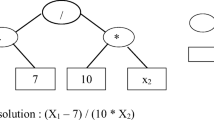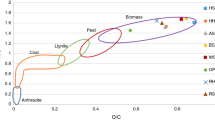Abstract
The higher heating value (HHV) is an important property defining the energy content of biomass fuels. A number of proximate and/or ultimate analysis based predominantly linear correlations have been proposed for predicting the HHV of biomass fuels. A scrutiny of the relationships between the constituents of the proximate and ultimate analyses and the corresponding HHVs suggests that all relationships are not linear and thus nonlinear models may be more appropriate. Accordingly, a novel artificial intelligence (AI) formalism, namely genetic programming (GP) has been employed for the first time for developing two biomass HHV prediction models, respectively using the constituents of the proximate and ultimate analyses as the model inputs. The prediction and generalization performance of these models was compared rigorously with the corresponding multilayer perceptron (MLP) neural network based as also currently available high-performing linear and nonlinear HHV models. This comparison reveals that the HHV prediction performance of the GP and MLP models is consistently better than that of their existing linear and/or nonlinear counterparts. Specifically, the GP- and MLP-based models exhibit an excellent overall prediction accuracy and generalization performance with high (>0.95) magnitudes of the coefficient of correlation and low (<4.5 %) magnitudes of mean absolute percentage error in respect of the experimental and model-predicted HHVs. It is also found that the proximate analysis-based GP model has outperformed all the existing high-performing linear biomass HHV prediction models. In the case of ultimate analysis-based HHV models, the MLP model has exhibited best prediction accuracy and generalization performance when compared with the existing linear and nonlinear models. The AI-based models introduced in this paper due to their excellent performance have the potential to replace the existing biomass HHV prediction models.





Similar content being viewed by others
Abbreviations
- AI:
-
Artificial intelligence
- ANN:
-
Artificial neural network
- CC:
-
Coefficient of correlation
- EBP:
-
Error back propagation
- GA:
-
Genetic algorithms
- GP:
-
Genetic programming
- HHV:
-
Higher heating value
- MAPE:
-
Mean absolute percentage error
- MIMO:
-
Multiple input–multiple output
- MISO:
-
Multiple input–single output
- MLP:
-
Multilayer perceptron neural network
- RMSE:
-
Root mean squared error
- SVR:
-
Support vector regression
References
Schenk PM, Thomas-Hall SR, Stephens E, Marx UC, Mussgnug JH, Posten C, Kruse O, Hankamer B (2008) Second generation biofuels: high-efficiency microalgae for biodiesel production. Bioenerg Res 1:20–43. doi:10.1007/s12155-008-9008-8
Boundy B, Diegel SW, Wright L, Davis SC (2011) Biomass resources overview in biomass energy data book, 4th edn. U.S. Department of Energy. http://cta.ornl.gov/bedb. Accessed 06 April 2013
Ciolkosz D (2010) Characteristics of biomass as a heating fuel. Document Code #UB043, Pennsylvania State University, pp 1–4. http://extension.psu.edu/pubs/ub043. Accessed 10 April 2013
Tahir MHN, Casler MD, Moore KJ, Brummer EC (2011) Biomass yield and quality of reed canary grass under five harvest management systems for bioenergy production. Bioenerg Res 4:111–119. doi:10.1007/s12155-010-9105-3
Parikh J, Channiwala SA, Ghosal GK (2005) A correlation for calculating HHV from proximate analysis of solid fuels. Fuel 84:487–494. doi:10.1016/j.fuel.2004.10.010
Sheng C, Azevedo JLT (2005) Estimating the higher heating value of biomass fuels from basic analysis data. Biomass Bioenerg 28(5):499–507. doi:10.1016/j.biombioe.2004.11.008
Jimennez L, Gonzales F (1991) Study of the physical and chemical properties of lignocellulosic residues with a view to the production of fuels. Fuel 70:947–950. doi:10.1016/0016-2361(91)90049-G
Yin CY (2011) Prediction of higher heating values of biomass from proximate and ultimate analysis. Fuel 90:1128–1132. doi:10.1016/j.fuel.2010.11.031
Cordero T, Marquez F, Rodriguez-Mirasol J, Rodriguez J (2001) Predicting heating values of lignocellulosics and carbonaceous materials from proximate analysis. Fuel 80:1567–1571. doi:10.1016/S0016-2361(01)00034-5
Daya Ram N, Abdul Salam P (2012) Estimation of higher heating value of biomass from proximate analysis: a new approach. Fuel 99:55–63. doi:10.1016/j.fuel.2012.04.015
Channiwala SA, Parikh PP (2002) A unified correlation for estimating HHV of solid, liquid and gaseous fuels. Fuel 81:1051–1063. doi:10.1016/S0016-2361(01)00131-4
Milne TA, Brennan AH, Glenn BH (1990) Source book of methods of analysis for biomass and biomass conversion processes. Elsevier, London
Friedl A, Padouvas E, Rotter H, Varmuza K (2005) Prediction of heating values of biomass fuel from elemental composition. Anal Chim Acta 544:191–198. doi:10.1016/j.aca.2005.01.041
ECN Phyllis (2012) The composition of biomass and waste. http://ecn.nl/phyllis/single.html. Accessed 09 April 2013
Hofbauer H, BIOBIB (2012) A database for biofuels. Institute of Chemical Engineering, Vienna University of Technology, Austria, Vienna. http://vt.tuwien.ac.at/biobib/info.html. Accessed 09 April 2013
IEA Bioenergy Task 32 (2013) Biomass combustion and cofiring. http://ieabcc.nl/database/biomass.php. Accessed 09 April 2013
Koza JR (1992) Genetic programming: on the programming of computers by means of natural selection. MIT, Cambridge
Poli R, Langdon WB, McPhee NF (2008) A field guide to genetic programming. Published via http://lulu.com/ and freely available at http://gp-field-guide.org.uk/; (With contributions by J. R. Koza). Accessed 22 January 2013
Banzhaf W, Nordin P, Keller RE, Francone FD (1998) Genetic programming: an introduction: on the automatic evolution of computer programs and its applications. Morgan Kaufmann, San Francisco
Wedge DC, Das A, Dost R, Kettle J, Madec M, Morrison JJ, Grell M, Kell DB, Richardson TH, Yeates S, Turner ML (2009) Real-time vapor sensing using an OFET-based electronic nose and genetic programming. Sens Actuators B 143(1):365–372. doi:10.1016/j.snb.2009.09.030
Wang XH, Li YG (2010) Stochastic GP synthesis of heat-integrated nonsharp distillation sequences. Chem Eng Res Des 88(1):45–54. doi:10.1016/j.cherd.2009.06.012
Hennessy K, Madden MG, Conroy J, Ryder AG (2005) An improved genetic programming technique for the classification of Raman spectra. Knowl-Based Syst 18(4–5):217–224. doi:10.1016/j.knosys.2004.10.001
Gray GJ, Murray-Smith DJ, Yun L, Sharman KC, Weinbrenner T (1998) Nonlinear model structure identification using genetic programming. Control Eng Pract 6(11):1341–1352. doi:10.1016/S0967-0661(98)00087-2
Yadavalli VK, Dahule RK, Tambe SS, Kulkarni BD (1999) Obtaining functional form for chaotic time series evolution using genetic algorithm. Chaos 9(3):789–794. doi:10.1063/1.166452
Banzhaf W, Langdon WB (2002) Some considerations on the reason for bloat. Genet Program Evolvable Mach 3:81–91. doi:10.1023/A:1014548204452
Patel SU, Kumar BJ, Badhe YP, Sharma BK, Saha S, Biswas S, Chaudhury A, Tambe SS, Kulkarni BD (2007) Estimation of gross calorific value of coals using artificial neural networks. Fuel 86:334–344. doi:10.1016/j.fuel.2006.07.036
Chavan PD, Sharma T, Mall BK, Rajurkar BD, Tambe SS, Sharma BK, Kulkarni BD (2012) Development of data-driven models for fluidized-bed coal gasification process. Fuel 93:44–51. doi:10.1016/j.fuel.2011.11.039
Kesgin U (2004) Genetic algorithm and artificial neural network for engine optimisation of efficiency and NO x emission. Fuel 83(7–8):885–895. doi:10.1016/j.fuel.2003.10.025
Tigas G, Lefakis P, Ioannou K, Hasekioglou A (2013) Evaluation of artificial neural networks as a model for forecasting consumption of wood products. Int J Data Anal Tech Strateg 5(1):38–48. doi:10.1504/IJDATS.2013.051739
Ioannou K, Arabatzis G, Lefakis P (2009) Predicting the prices of forest energy resources with the use of artificial neural networks (ANNs). The case of conifer fuel wood in Greece. J Environ Prot Ecol 10(3):678–694
Koutroumanidis T, Ioannou K, Arabatzis G (2009) Predicting fuelwood prices in Greece with the use of ARIMA models, artificial neural networks and a hybrid ARIMA-ANN model. Energ Policy 37(9):3627–3634. doi:10.1016/j.enpol.2009.04.024
Rumelhart DE, Hinton GE, Williams RJ (1986) Learning representations by back-propagating errors. Nature 323:533–536. doi:10.1038/323533a0
Tambe SS, Kulkarni BD, Deshpande PB (1996) Elements of artificial neural networks with selected applications in chemical engineering, and chemical & biological sciences. Simulation & Advanced Controls, Louisville
Freeman JA, Skapura DM (1991) Neural Networks: Algorithms, Applications, and Programming Techniques. Addison-Wesley, Reading
Bishop CM (1995) Neural networks for pattern recognition. Oxford University Press, Oxford
Nandi S, Badhe Y, Lonari J, Sridevi U, Rao BS, Tambe SS, Kulkarni BD (2004) Hybrid process modeling and optimization strategies integrating neural networks/support vector regression and genetic algorithms: study of benzene isopropylation on Hbeta catalyst. Chem Eng J 97(2–3):115–129. doi:10.1016/S1385-8947(03)00150-5
Schmidt M, Lipson H (2009) Distilling free-form natural laws from experiment al data. Science 324(5923):81–85. doi:10.1126/science.1165893
Mierswa I, Wurst M, Klinkenberg R, Scholz M, Euler T (2006) YALE: rapid prototyping for complex data mining tasks. In Proceedings of the 12th ACM SIGKDD International Conference on Knowledge Discovery and Data Mining (KDD-06)
Acknowledgments
This work was partly supported by the Council of Scientific and Industrial Research (Network project: Tapcoal), Government of India, New Delhi.
Author information
Authors and Affiliations
Corresponding author
Electronic supplementary material
Below is the link to the electronic supplementary material.
ESM 1
(DOCX 183 kb)
Rights and permissions
About this article
Cite this article
Ghugare, S.B., Tiwary, S., Elangovan, V. et al. Prediction of Higher Heating Value of Solid Biomass Fuels Using Artificial Intelligence Formalisms. Bioenerg. Res. 7, 681–692 (2014). https://doi.org/10.1007/s12155-013-9393-5
Published:
Issue Date:
DOI: https://doi.org/10.1007/s12155-013-9393-5




